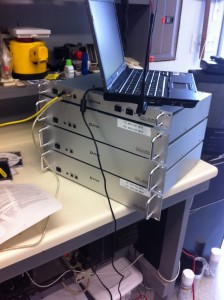Amateur Radio and the world of VHF and UHF Repeaters
The 2 meter and 70 cm ham radio bands are the most popular of all of the ham radio bands and this is where generally most new hams start out in their journey. The 2 meter band is a VHF or Very High Frequency band and 70 cm band is a UHF or Ultra High Frequency band.
Upon obtaining an amateur radio license or “ticket” the majority of new amateur radio operators make their first investment in a dual-band hand held two way UHF/VHF radio, commonly referred to as an HT or Handy talkie, a name which developed from the old phrase: walkie-talkie. Regularly the amateur radio operators second investment is a mobile dual-band VHF/UHF transceiver or “rig” which they can mount in their vehicle or home station. These two radios have very similar functionality but the hand held battery-operated rig is regularly limited to a maximum output power of about 5 watts. The mobile rig which is connected to the vehicles 12 Volt battery, or if it used as a base station, to a power supply providing 12 Volts DC and is capable of transmitting 35 to 50 watts of power.
Here are some photos of some typical handheld radios that are available:
The Kenwood TH-6FA Triband Handheld and the Yaseu FT-60R 2 meter Handheld.
Unlike HF High frequency radio waves which can propagate around the world VHF and UHF radio frequencies are line of sight only. Depending on the power output and the location of the transmission antenna UHF and VHF transmissions are capable of reaching the visible horizon and maybe just slightly beyond, but that is the limit. There is one notable exception to this rule which is Tropospheric ducting, where under very unusual and not that all rare weather conditions VHF and UHF radio signals travel very much further than the horizon. Ham radio operators take advantage of this phenomenon when it does occur by communicating with other hams over immense distances. This aspect of amateur radio is called “weak signal” which is carried on both the VHF and the UHF band along with higher frequency bands called “Microwaves.”
A 5 Watt HT will have an operative range “based on the elevation and terrain” of around 3 to 5 miles. A mobile rig on maximum power with a reasonable antenna in a good location will most likely have a maximum range of 10 to 20 miles under favorable conditions. To overcome this limitation in range ham radio operators employ radio systems called “repeaters”, which are generally owned and operated by ham radio clubs, but some are privately owned. These repeaters are automatic transceivers that listen or receive on one frequency and transmit on a different frequency; this is usually referred to as “the split”. The repeater takes the signal that it receives on the input frequency and instantaneously retransmits it on the output frequency using a lot more power generally about a 25 to 100 Watts. In addition to the higher power most of these radio repeaters antennas are located on the top of very high buildings, mountain tops or towers which effectively increases the range.
Photos of typical mobile radios:
The Alinco DR-135 2 meter mobile radio and the Icom 2 meter and 70 cm dual band mobile.
A ham’s HT can be used to transmit on the radio repeater’s input frequency and receive on the radio repeater’s output frequency in effect increasing the range of the hand held radio to just beyond the horizon maybe even as much as 35 or 50 miles. Many repeater systems located in larger cities have several receiving antennas located throughout the radio repeater’s coverage area but just one main transmitter. In this way a large city can be completely covered with a repeater system with hams being able to receive the repeater just about anywhere in the city and they are able to be received by the repeater or “hit the radio repeater” as it is commonly referred to, again from almost anywhere in the city.
 In recent times some repeaters around the world have been connected to the World Wide Web and can be linked to each other by the use of the Internet. For example a ham radio operator in Hamburg, Germany with a Handy-talkie can chat, through their local repeater with a fellow ham who is driving in their car in Omaha, Nebraska. Some repeater systems are continually linked to each other but mainly are linked as and when needed by the user and the link being switched off at the end of the 2 way transmission or QSO as it is called by Amateur radio operators.
In recent times some repeaters around the world have been connected to the World Wide Web and can be linked to each other by the use of the Internet. For example a ham radio operator in Hamburg, Germany with a Handy-talkie can chat, through their local repeater with a fellow ham who is driving in their car in Omaha, Nebraska. Some repeater systems are continually linked to each other but mainly are linked as and when needed by the user and the link being switched off at the end of the 2 way transmission or QSO as it is called by Amateur radio operators.
Most amateur radio repeaters are open to all licensed amateur radio operators without charge. These repeaters do take money to operate and maintain. They are customarily funded by club membership dues, donations and events held by the club like Hamfests. If a ham finds him or herself using a radio repeater frequently then they should really consider joining the club or support the individual that owns the repeater and help to fund it. It is also important for him or her to also take the time to honor and thank the hams who give generously of both their time and technical abilities to build and maintain the repeaters that they enjoy using.